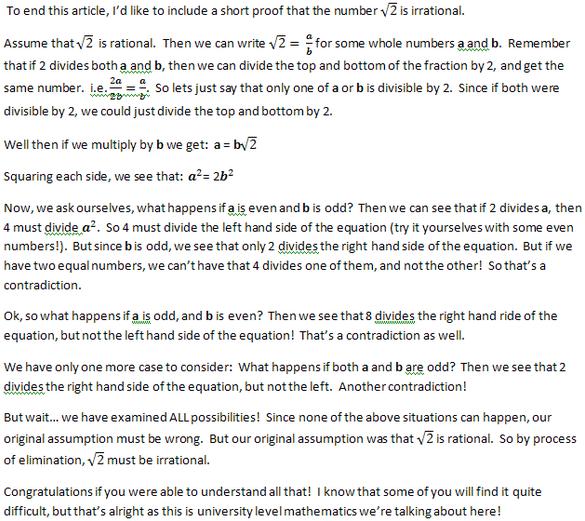|
|
Hey Whyvillians! Before I get this article started, I should tell you that I am a student studying mathematics at a university in the U.K. That means, as unfortunate as this may sound, that I study mathematics all the time. It's not like in Canada or America, where it means you study mathematics as a major, then study some smaller subjects as minors. I only study mathematics. But don't feel sorry for me just yet! I enjoy what I do, which is why I am about to give you a very short, but (hopefully) interesting, math lesson.
It all started around 470 B.C. A well known philosopher and mathematician, Pythagoras of Samos, started a band of mathematicians called (shamelessly) the Pythagoreans. They were a very secretive group, who believed that there was no point in learning only a little mathematics, if you would not devote your entire life to it. Author's Note: Don't worry, I don't particularly agree with him on that one! They were very talented, and were at the forefront of geometry and number theory.
One of the main ideals of the Pythagoreans was something called commensurability. If you take any two line segments, then they believed there exists a third line segment which, if you lay it down end-to-end several times, then you will exactly cover either one of the first two line segments (probably with different numbers of the third line segment). Pythagoras was a firm believer of this fact. He believed that geometry was so perfect, that how could two line segments not be commensurable? Although he lived by this fact, he had no logical way of proving it.
Today, we would rarely say that two things are commensurable. Instead, we say a number is rational if it can be expressed as a fraction of two integers. E.g. 12 is a rational number. It is the fraction 12 divided by 1. Also, 3.5 is a rational number, since it is just 7 divided by 2. Another example would be 0.3333333333333 with infinitely many 3's at the end. This is just (I'm sure some of you know) 1 divided by 3. So Pythagoras, and most of his followers, believed that every number was rational. They believed that every number could be represented by the fraction of 2 numbers.
He was wrong. One member of the Pythagoreans was studying the square for a long period of time (how exciting!). He noticed that if you take a side of a square, and the diagonal of the same square, they are incommensurable. There is no line segment small enough that, when laid end to end several times, will cover exactly both the side of a square, and it's diagonal. This was a very startling fact for the young man, and when he presented it to Pythagoras, he was not rewarded. Pythagoras had Hippasus drowned for daring to believe two lengths could be incommensurable.
But it was too late. The mathematical world was building momentum. The discovery that the side of a square and its diagonal were incommensurable was a startling fact. (Some of you may know that the length of the diagonal of a square, divided by the length of one of its sides is the square root of 2). Mathematicians everywhere welcomed the discovery, and the search for irrational numbers began.
Now, the formal definition of an irrational number is a number which cannot be expressed as the fraction of two integers (i.e. whole numbers). And mathematics has evolved very much so since 470 B.C. It was soon discovered that the square root of any number that was not the square of another whole number, was in fact irrational. More irrational numbers started popping up. The famous number Pi, which is approximately 3.14159 is the number you get when you divide the circumference of a circle by it's diameter. Irrational numbers started appearing everywhere! It was proven within the last 100 years that there are in fact MORE irrational numbers than rational ones! And to think that it took us this long to find an example of just one!

I hope you all enjoyed my story about irrational numbers. They've played an important role in the development of mathematics. We've found out that a lot of the most important numbers in mathematics and physics are irrational. We've found out how they were invented, and what they are. If you're feeling even more curious, then feel free to do a bit of your own research, or if you're very enthusiastic, you can y-mail me and ask for more information.
This is Deriko, clicking off to do some mathematics homework!
Q.E.D.
|